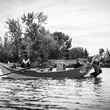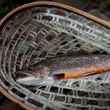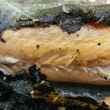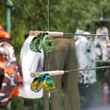During the next 4-6 weeks, fly fishermen in the eastern United States -- from North Carolina and north to Connecticut and New York -- may be able to enjoy something that their western brethren find relatively commonplace, but is rarely experienced on eastern waters: throwing big bugs to voracious trout that aren’t the least bit picky about pattern or presentation.

This year marks the year of the emergence of the Magicicadas, also known as the 17-year or Brood II cicadas. These periodical cicadas, the longest living insects in North America, will emerge in massive numbers throughout the eastern United States with concentrations in some areas approaching 1.5 million insects per acre.
These insects, who have been living underground since 1996, will emerge when the average soil temperature reaches 64 degrees. As their wings harden after emergence, they will take flight to the trees where they will pursue a mate. After mating, these insects will fall to the ground, littering meadows, forest floors and rivers and streams. Unsuspecting trout will quickly key on this bounty of protein, gorging themselves on these readily available bugs.

This should sound like music to the ears of eastern fishermen, who are deprived the famed hatches of big bugs such as that of salmonflies on the Deschutes and Yellowstone Rivers or the feeding frenzies that take place on many western rivers when terrestrial season swings into full gear. For once, eastern anglers will have a reason to carry size 6 flies in their box that aren’t meant to be attached to a sink tip.
Where To Find Them
As mentioned, some areas will be absolutely blanketed by cicadas. But, despite the way some regions will be overwhelmed with these relatively harmless insects, other areas will miss them entirely.
Brood II periodical cicadas are found in CT, MD, NC, NJ, NY, PA and VA.
The following provides information by state on what counties are expected to see a Magicicada emergence in 2013: CT (Hartford, Middlesex, New Haven), MD (Anne Arundel, Calvert), NJ, NY (Albany, Oneida, Orange, Richmond, Rockland), PA, VA.
You can also track recent cicada sightings through magicicada.org. Here you'll be able to search by map for recent sightings of cicadas in your area, with information on location and life stage observed.

Fly Patterns
There are a large number of cicada patterns out there. Some are tied with the goal of representing a specific cicada emergence, but most are general patterns that serve to imitate a variety cicadas. The majority of these patterns are tied with foam, due to its high and long floating properties, and the ability to easily build up a large body like that of the cicada. Appropriate sizes for the Brood II cicadas are around 6 to 8.
If you’re looking to tie your own, an excellent pattern to fish or a starting point for your own cicada creation is Loren Williams’ Periodical Cicada. A simple and elegant tie, William’s cicada covers the essentials of both form and function in a cicada pattern. As Williams explains, “The pattern must be built so that it will "splat" resoundingly. Too much fluff will slow it's descent. Third, cicadas have oversized, and very apparent wings. They need to be included. The trick then is to sum these all into a pattern that will float, catch fish, and not require an epoch at the vise.”

If you’re not a tier or don’t have time to get in front of the vice before you expect magicicadas in your area, Montana Fly Company has a number of cicada patterns that will likely fit the bill (seen below).

Drowned cicada patterns are another option for trout that seem to be ignoring high-floating foam patterns. Patterns made to represent a drowned cicada are usually made from natural materials and are designed to allow the fly to float with most of the fly body below the surface.
How to Fish Them
Cover Water: Though cicadas are terrestrials, they are flying insects and can land anywhere on the water’s surface. Be sure to cover lots of water in search of trout looking for a big meal.
Presentation: Cicadas are somewhat clumsy fliers and will often crash or “splat” onto the water’s surface. Your presentation should reflect as much, though be sure not to overdo it, spooking the whole pool. And of course, feel free to experiment with softer presentations. Though trout feeding on cicadas will often be aggressive, drag free drifts remain important, as trout will often move large distances to take a cicada.
Setting the Hook: Though a trout charging your cicada fly may get your heart racing, concentrate on waiting an ample amount of time to set the hook. Cicadas are big bugs, and as such, it takes a trout more time to take and close its mouth on such a large meal. Waiting that extra moment or two can result in a much higher hookup rate.
Before long, these long-awaited bugs will start appearing on many eastern lakes, streams and rivers and most fishermen of the region would be smart to pursue them. It is worth remembering that these are big, meaty insects that even the oldest trout in your local stream has never seen the likes of. It may take some time after cicadas begin to fall to the water's surface before trout begin to key in on them and take them as food. That said, cicada patterns may continue to work for weeks after the naturals have gone, as memories of hearty meals linger in the minds of hungry trout.































Comments
ginkthefly replied on Permalink
This can't come fast enough.
... Actually, it might be nice if it came a bit late after the mayflies start to dwindle.
Chad Shmukler replied on Permalink
Looks like that might just be what happens in the NE.
The_Riffler replied on Permalink
This is smaller than the hatch in 2004, right? But covering a bigger area?
Pages